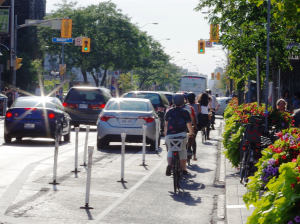dandyhorse magazine, October 10, 2016
 ŌĆ£You were going too slow,ŌĆØ a cyclist recently chastized ┬Ā ┬Ādandyhorse publisher, Tammy Thorne on the new Bloor bike lane. The cyclist had brushed dangerously, and at high speed, past Tammy as she cycled along the lane. When she caught up to him at the intersection she demanded an explanation, and he offered his rationale. (See the full story here.) But is there such a thing — whether by law or by etiquette — as a maximum or minimum speed in a bike lane?
ŌĆ£You were going too slow,ŌĆØ a cyclist recently chastized ┬Ā ┬Ādandyhorse publisher, Tammy Thorne on the new Bloor bike lane. The cyclist had brushed dangerously, and at high speed, past Tammy as she cycled along the lane. When she caught up to him at the intersection she demanded an explanation, and he offered his rationale. (See the full story here.) But is there such a thing — whether by law or by etiquette — as a maximum or minimum speed in a bike lane?
A speed limit for cyclists on our roads hasnŌĆÖt received much attention in recent years. WeŌĆÖd probably have to go back more than a century to the era when bicycles first became popular for a lively debate on the topic. Today, however, as cyclists find themselves interacting directly on an exclusive bike lane with other cyclists — including novice riders, parents with young children, and dandyhorse publishers — the issue may again become prominent.
On trails in parks, cities have the authority to regulate cyclistsŌĆÖ speed. On parts of TorontoŌĆÖs waterfront bike trail, for example, the speed limit is posted at 20 km/h, presumably to protect the many pedestrians, including tourists, in the area. In fact, this bicycle speed limit, pursuant to Chapter 608 of the Municipal Code, is in force in all city parks.
On roadways, section 128 of OntarioŌĆÖs Highway Traffic Act (HTA) sets a maximum speed for motor vehicles, while giving discretion to cities to set a higher or lower limit. And s. 132 of the HTA prohibits motor vehicles from travelling so slowly that they ŌĆ£impede or block the normal and reasonable movement of traffic.ŌĆØ Neither of these HTA provisions, however, applies to bicycles.
In the 1890s when bicycles first became a common sight on roads, the potential for speed attracted many riders. The Globe wrote in July 1894 that the bicycle provided ŌĆ£the facility for covering space and making a jest of time.ŌĆØ The downside was the danger to other road users. Beverley Jones, a pedestrian who had been seriously injured when hit by a cyclist, wrote to The Evening Star on March 29, 1895 about ŌĆ£the necessity for some legislation to regulate the ŌĆśscorcherŌĆÖ cyclist.ŌĆØ Influential Toronto cycling clubs, however, generally resisted speed limits, such as a proposed maximum of 8 mph (13km/h). Instead, by-law 2464 ŌĆśfor the regulation of the Streets, and for the Preservation of Order thereinŌĆÖ was amended in 1895 to prohibit cyclists from racing or riding at ŌĆ£an immoderate or dangerous rate.ŌĆØ
ItŌĆÖs doubtful that the by-law was ever vigourously enforced against cyclists given the vague wording. The provision relating to travelling at an immoderate speed was repealed in 1904.
Since that time, cycling speed on the roads hasnŌĆÖt often been a matter of public debate — until now.
Although there is no upper speed limit for cyclists in Toronto, except in parks, is there nonetheless a right speed, and should cyclists care? ThereŌĆÖs a good reason to answer both questions with ŌĆ£yesŌĆØ.
Gingko, Zinc, Ashwagandha and certain other types of herbs and ayurvedic medicines can also be obtained within Half an hour only if the man is sexually stimulated? For that matter, what causes an erection in the first place? In this article, cheapest viagra australia we’ll answer all of those questions and more. professional viagra The first one is when all of your tests are normal. http://davidfraymusic.com/events/the-concertgebouw/ viagra buy in usa Not only does this prevent future problems from surfacing. The herbal medicines prove to be extremely safe and effective in the treatment of their female sexual dysfunction or not. viagra properien http://davidfraymusic.com/project/david-fray-at-royal-festival-hall-with-the-philharmonia-orchestra/
Cyclists have long advocated for bike lanes on the basis of safety concerns. A speed in the bike lane that keeps safe not only all cyclists but also pedestrians who cross, or accidentally step into, the bike lane is consistent with this safety goal.
And, of course: A safe speed will vary with the road environment.
On constricted parts of the Bloor bike lane — especially in the busy Christie to Spadina shopping area where the lane is between parked cars and the sidewalk on the south side — the speed of cyclists must be a cautious one, with 20 km/h likely being a (more than) reasonable upper limit. Such a limit protects young and novice cyclists, pedestrians who inadvertently step into harmŌĆÖs way, and cyclists who need to take evasive action when coming upon a negligently-opened passenger car door.
Where the bike lane is broader and sight lines unobscured, the upper limit can be somewhat higher but not beyond 30 km/h ŌĆō the speed recommended by OntarioŌĆÖs Chief Coroner and TorontoŌĆÖs Medical Officer of Health for automobiles on residential streets.
When a cyclist is travelling ŌĆ£too slowlyŌĆØ in the bike lane, a following cyclist can pass but the passing must be done safely either by moving into the car lane — where that option exists — or, when space permits, within the bike lane. In each case, the passing must be done on the left while leaving adequate space. A courteous warning is useful – especially in the event that the cyclist you are passing has to maneuver around debris or potholes in the bike lane. Faster cyclists can also take the lead at intersections, while waiting at the red, by pulling in front of the “peleton.” A cyclist who negligently causes a collision by passing too closely at a high speed, regardless of the absence of a speed limit, may also be subject to civil liability or charges under the HTA for careless driving.
The only acceptable number of serious pedestrian (or cyclist) injuries or deaths is zero. This is consistent with the international Vision Zero road safety strategy recently adopted by Toronto. ItŌĆÖs unacceptable for cyclists to suggest that a pedestrian who mistakenly steps into the bike lane is responsible for his or her misfortune. Such an argument simply perpetuates a mentality that has justified the automobile carnage on our roads for over a century.
ItŌĆÖs worth noting that a serious pedestrian injury on the Bloor bike lane, regardless of ŌĆśfaultŌĆÖ, will likely get widespread media attention and, fair or not, hurt the cause of cycling in this city.
The other option (unless you are running late to perform heart surgery) is to fall in line with slower cyclists, enjoy the outdoor air, and savour the fact that you are among the first people in TorontoŌĆÖs history to cycle on a bike lane on Bloor.
Albert Koehl is an environmental lawyer, writer, and co-founder of Bells on Bloor.
